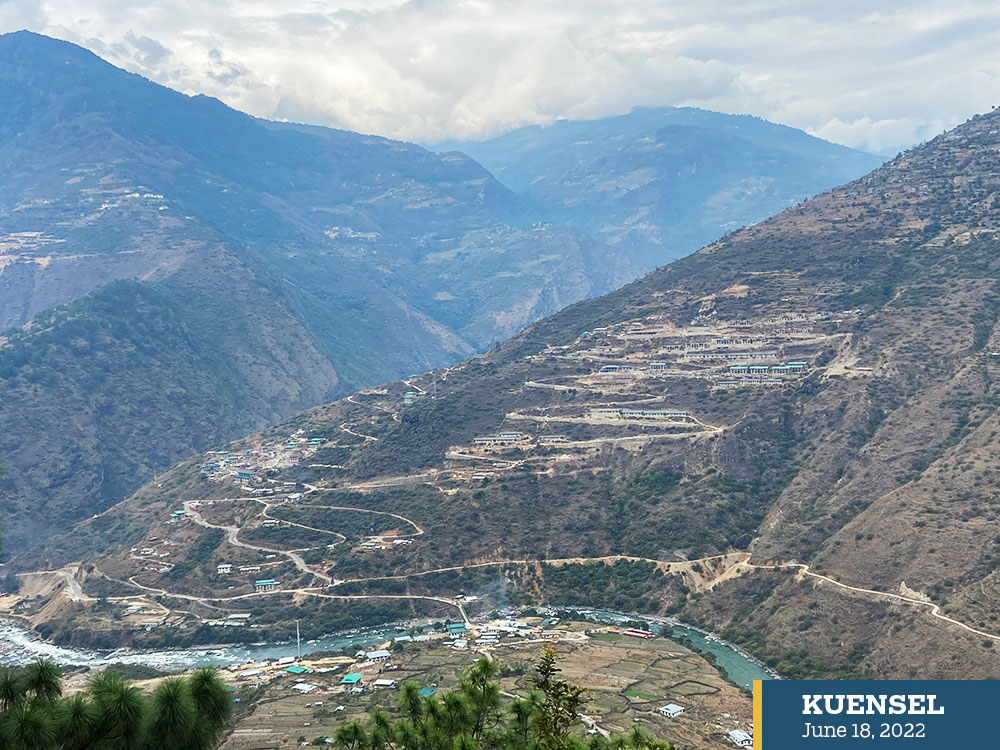Nima Wangdi
The Kholongchhu Hydro Energy Limited or KHEL was seen as the harbinger of development in the otherwise sleepy Doksum town, Trashiyangtse. The project came and it led to a beehive of construction activity with many pinning their hopes on the project.
A direct benefit of the 600MW proposed project, at least to Yangtse locals, was from the increased economic activity with demand for housing and other small scale businesses. Many invested in constructions. Some buildings have been completed and more are expected to be completed in the next few months. However, uncertainties of the future of the biggest project in eastern Bhutan has left locals worried.
Sangay Choda, a businessman in the town, said he relied on KHEL for opportunities. He expected the project to bring better business. Sangay and others took loans and invested in construction with the hope that there will be demand for housing.
Sangay will have to start repaying the loan in monthly installments from this month. He is worried.
This is because there is an abrupt halt on the project that promised so much to the locals besides adding to the country’s hydropower generation.
At Doksum, some hoteliers started business. But there are no customers. “Some people are selling their land after not seeing any prospects in the town,” said Sangay Choda. “With not even basic amenities like clean drinking water, street lights, pedestrian paths, and parking areas put in place, there is almost no one visiting the town today.”
Doksum town’s Tshogpa, Karma Lhamo said KHEL is supposed to occupy 200 units of residential space in the town. She said project officials today occupy five buildings and the rest are empty.
If the project would take off is not sure. What is clear is that those who took loans to invest in housing will have to repay soon. “We don’t know if the project is getting delayed or scrapped,” said Karma Lhamo, who will complete her building in a few weeks. “My only worry is the financial institutions will seize our buildings if we fail to repay,” Karma Lhamo said.
KHEL roughly translates to game or play in Hindi. Locals are thinking the project and the government are playing with their lives and livelihood. Tongmijangsa Gup, Ugyen Dorji said the delay of the project has been a problem for the gewog since 95 percent of the project falls in his gewog. “Initially, during the project site development phase, villagers benefitted in so many ways but about 80 percent of the construction workers have left by now.”
He said the project provided market for farmers and that those who constructed buildings earned good rental income. However, with uncertainties surrounding the project, the gup is worried. “People are asking about the project since they have sacrificed much for the project like their land. Some have not yet received land compensation or land replacement.”
Ugyen Dorji said that the delay also hampered the gewog’s development plan as the master plan was linked with the project. The gup said his gewog has not been able to blacktop its gewog road since KHEL was supposed to do it. “We have also built two market sheds where villagers could sell their farm produce. It will be useless if the project doesn’t come through.” There is an earmarked budget to build two more.
He said he is optimistic that the project may be delayed, but would not be scrapped. “Both the government and the community would have to bear heavy losses if it got scrapped.”
Trashiyangtse Thromdey representative, Jamba Sonam said vehicles KHEL hired were asked to discontinue after completion of their contract term. The project cancelled contracts of about 15 vehicles recently. Jamba Sonam said the head office of the project is based in Trashiyangtse town and the houses where project employees resided on rent have also been vacated.
KHEL officials said that there is no development in the project as of now, but the usual contract works are being carried out at the minimal cost.
In an earlier interview, project officials said that tendering of two of the three main civil works of the project: construction of the dam and the powerhouse could not be resolved due to differences between shareholders, DGPC, and the Indian company, SJVN. Construction of the Head Race Tunnel had started as of January this year.
Out of the Nu 20.276 billion for all three projects, the dam is worth Nu 9.72 billion and the powerhouse, Nu 6.21 billion.
The 600 MW Kholongchu project commenced in 2015 and was supposed to be completed in 2020. Upon completion, it’s expected to generate 2,568M units of electricity annually.
KHEL is the first-ever joint venture hydropower project in Bhutan and it is formed between Druk Green Power Corporation and India’s SJVN. An expert said, given the current experience, this might be the last JV project for Bhutan.


